International Resin Modellers Association©SM®TM
SITE UPDATE! As Yahoo! Site Solutions is no longer being updated or maintained after today, Thursday 31 March 2022, IRMA will be moving to a new provider. This will take us some time, so please be patient. We will be listing kit release dates on our new site. Thank you for your patience and understanding.
International Resin Modellers Association ©SM®TM
Zane R Nobbs
405 Old Orchard Drive, 18
Essexville, MI 48732
United States
ph: 001-989-891-1401
fax: 001-989-891-1401
alt: 001-989-465-6241
info
- Home
- Updates!
- About Us
- Contact Us
- IRMA On-Line Store
- Services
- Corporate Services
- Memberships
- Resin Manufacturers 1
- Resin Manufacturers 2
- Resin Manufacturers 3
- Resin Manufacturers 4
- Resin Manufacturers 5
- Resin Manufacturers 6
- Resin Manufacturers 7
- Resin Manufacturers 8
- IRMA President & Founder
- Resin Manufacturer of the Year
- Resin Manufacturer of the Month
- Resin Manufacturer of the Month 2
- Hobby Suppliers and Organizations
- Corporate Sponsors
- Wish List!
- Members Page 1: Francisco Jose Conde
- Members Page 2: Tom Zuijdwegt
- Members Page 3: Robert Meguid
- Members Page 4: Francisco Jose Conde
- Members Page 5: Armando Gil
- New Releases
- Articles 1: Resin: The Greener Format
- Articles 2: Building a Gloster CXP-1001
- Articles 3: Nakajima J9N1 Kikka
- Articles 4: An IRMA Company?
- Articles 5: Gloster CXP-1001
- Articles 6: Hong Zhuan-503/Shenyang JJ-1
- Articles 7: Tribute to Jean Pierre Dujin
- Articles 8: Copied Kits
- Articles 9: Building a Shenyang JJ-1
- Articles 10: Why First Chinese Jets for IRMA Kits?
- Articles 11: Coandă-1910
- Articles 12: Building the Coandă-1910
- Articles 13: Varga RMI-1 X/H
- Articles 14: Building the Varga RMI-1 X/H
- Articles 15: CTA Heliconair HC-I, -II Convertiplano
- Articles 16: Building the CTA Heliconair HC-I
- Articles 17: Flug-und Fahrzeugwerke Altenrhein FFA P-16
- Articles 18: Building the Flug-und Fahrzeugwerke Altenrhein FFA P-16
- Articles 19: Fokker F.26 Phantom
- Articles 20: Building the Fokker F.26 Phantom
- Articles 21: Avro Canada C-102 Jetliner
- Articles 22: Building the Avro Canada C-102 Jetliner
- Articles 23: Tupolev Tu-12
- Articles 24: Building the Tupolev Tu-12
- Articles 25: NACA - Langley - Jacobs - Jeep
- Articles 26: Building the NACA - Langley - Jacobs - Jeep
- Articles 27: Campini-Caproni CC.7 (CS.11) Toscana
- Articles 28: Building the Campini-Caproni CC.7 (CS.11) Toscana
- Articles 46: Messerschmitt Me-262
- Articles 47: Orion III Space Clipper
- Articles 48: Building the Orion III Space Clipper
- Trades & Exchanges
- Reviews Page 1: PJ Production
- Reviews Page 2: ItalianKits/Cunarmodel
- Reviews Page 3: Bel-Air Models
- Reviews Page 4: Marsh Models - Aerotech
- Reviews Page 5: OMEGA Models
- Reviews Page 6: Sword Models
- Reviews Page 7: Prop & Jet
- Reviews Page 8: WHIRLYKITS
- Reviews Page 9: DEKNO MODELS
- Reviews Page 10: France'41
- Reviews Page 11: Bird Models
- Reviews 12: Uncle Les Models
- Reviews Page 13: RVHP Models
- Reviews Page 14: VSV Models/Travers Decals
Articles 25
N.A.C.A. - Langley - Jacobs - Jeep

Model and photographs by Zane R Nobbs
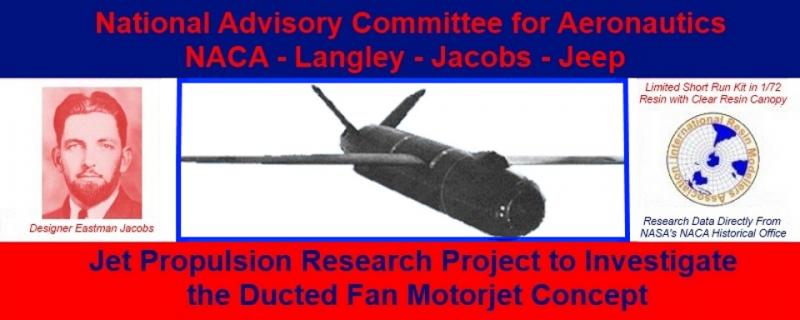
Box design and boxart by Zane R Nobbs
At the beginning of the Second World War the United States of America had initiated research into turbojet development with the first American made engine being the Lockheed L-1000 (J-37) axial-flow turbojet which was to power the Lockheed L-133 canard-winged pursuit aircraft of 1940 (1/72 Sharkit). Unfortunately the L-1000 was never successful on its own. The first successful all American jet engine was the Westinghouse J30 which powered the McDonnell XFD-1 Phantom via two jet engines in 1945 (1/72 MPM).
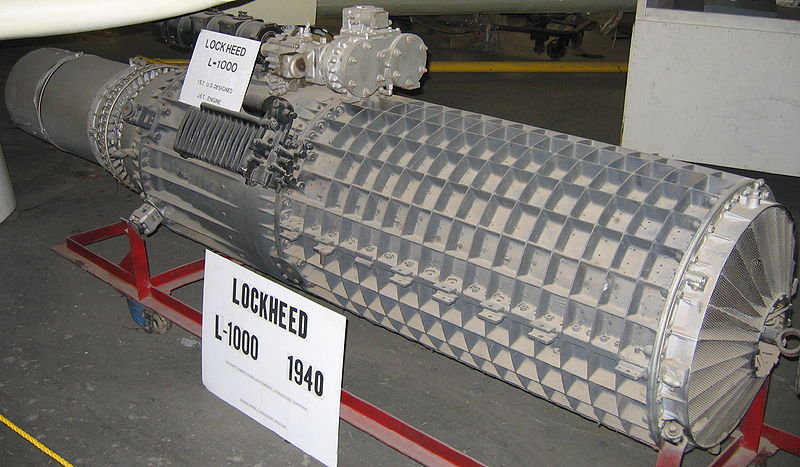
Lockheed L-1000 - photographed at Planes of Fame Musuem, Chino, California
The US Army Air Force (USAAF) and the US Navy (USN) were watching developments taking place in Europe and Asia as far as jet power. In France Henri Mélot was working on a form of ramjet as early as 1935 with construction of an airframe by Nicolas Payen for the Payen-Melot Flechair (arrow) (1/72 Unicraft). Meanwhile René Leduc was constructing a jet aircraft powered by his own Leduc Thermo-Propulsive Unit prior to hostilities. In Italy Secondo Caproni developed the Campini-Caproni CC.2 (1/72 Delta2, Valom) utilizing a motor jet in which a conventional piston engine, the Isotta Fraschini L.121/R.C.40, turned a gas-turbine, a Campini Motorjet, to force the air through the engine. This was similar to Henri Coandã's aircraft, the Coandã-1910 (1/72 IRMA), in which a Cleget piston engine drove a Coandã Air-Reactive Unit. Meanwhile in Germany Dr. Hans von Ohain started with a centrifuge for his Heinkel-Strahltriebwerk HeS 1, but then took the axial-flow approach with his Heinkel-Strahltriebwerk HeS 8 in which the air flows into the engine and runs parallel to the axial before thrusting out the back. In the United Kingdom Sir Frank Whittle had derived a centrifuge turbojet, the Whittle Supercharger Type W.1, in which the air was pushed to the outer rim of the engine before being forced out the back after fuel injection. Dr. György Jendrassic, in Hungary, was designing a turboprop in which the air was forced into the engine and expelled as in a turbojet, but part of the power also turned propellor blades to aid in locomotion. This was the Jendrassik Cs-1. In the Soviet Union Arkip Lyulka was working on centrifuge and axial-flow gas turbines, the RTD-1 and VDR-2 respectively, while in Japan research into ramjets and gas turbines such as the Kayaba Model 1 and Ishikawajima Ne-20 had begun even before knowledge of German developments.

Melot's steam-oil engine concept - Everyday Science and Mechanics, October,1935
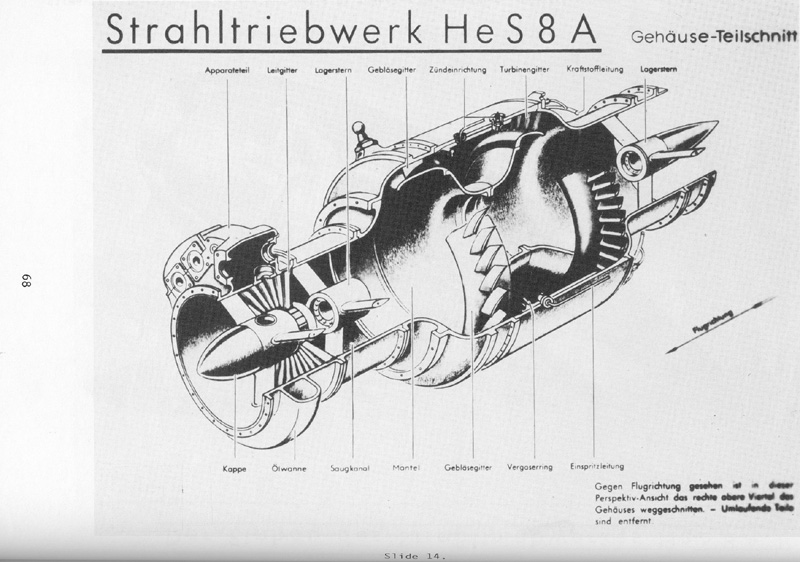
Heinkel-Strahltriebwerk HeS 8 axial-flow turbojet - USAAF photograph
With so many varied approaches, the USA decided to investigate different avenues. The USAAF encouraged Lockheed to continue with the L-1000/L-133 project with the axial-flow engine while at the same time collaborating with the United Kingdom on a centrifuge approach via Bell Laboratories design of the Bell P-59 Airacomet (1/72 ANiGRAND, speciaL hOBBY, Amodel, Karo-As) powered by two American made General Electric I-A turbojets which were actually derived from the British Power Jets W1. Yet another plan was being promoted by the National Advisory Committee for Aeronautics, a civilian research agency, at their Langley location in Virginia. This program was supervised by Eastman Jacobs who believed that a motorjet of the Campini-Caproni type would be the quickest and most economical approach for the USA to get on par with Italy, Germany, and Great Britain.
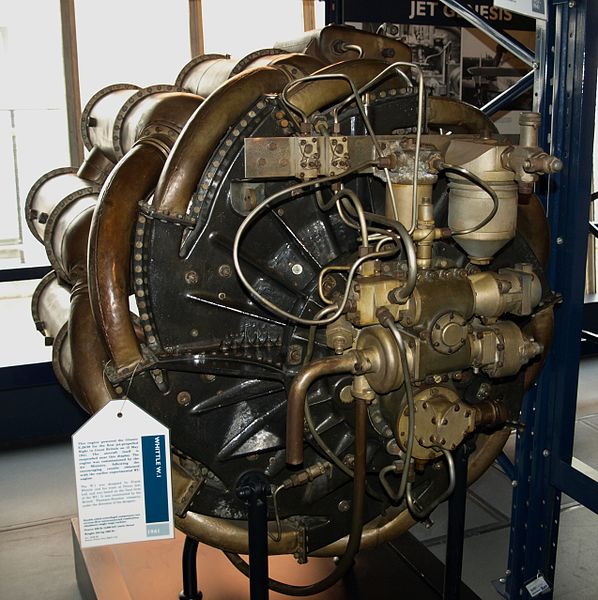
Power Jets W.1 centrifuge turbojet - Science Museum, London, England
Dr. Jacobs began research in earnest, unaware of any other projects due to the government "compartmentalizing" them, meaning that research was conducted independently with each party being unaware of what the others were doing. Dr. Jacobs designed an engine and airframe that came to be known as the "Jeep" in accordance with the motorized vehicle of the US Army for which the term Jeep meant something that could basically go anywhere and be adopted to just about any purpose.
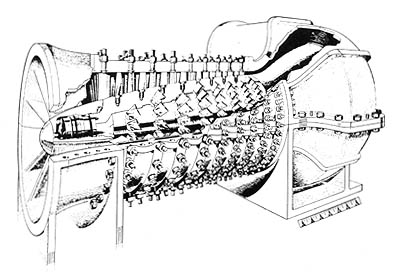
NACA eight-stage axial-flow compressor designed by Eastman Jacobs and Eugene Wasielewski, 1938 - NASA-NACA image
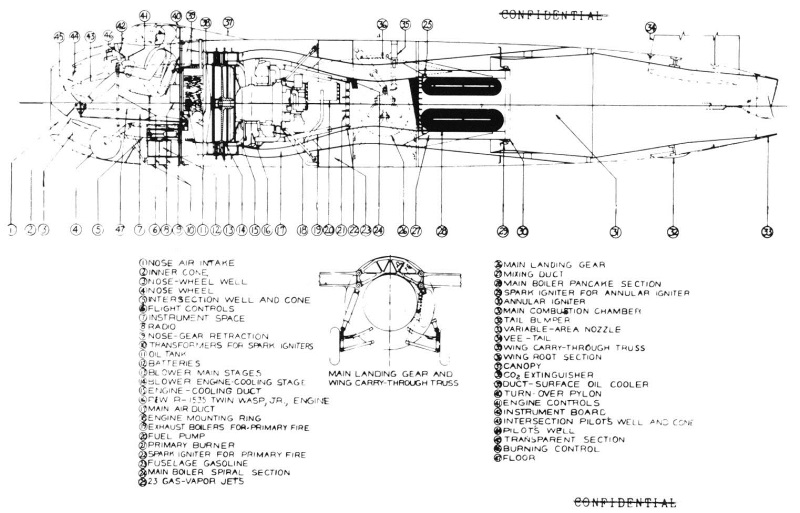
NACA-Langley Test Airplane designed by Dr. Jacobs, 1942 - NASA-NACA image
For his aircraft Jacobs utilized a Pratt & Whitney PR-1535 Twin Wasp Jr piston engine driving a gas-turbine of his own design, the NACA motojet. The structure was basically a tube with simplified main wings and a vee-tail with a tricycle undercarriage. His main goal was to simplify every aspect of the aircraft for speed of testing and production.
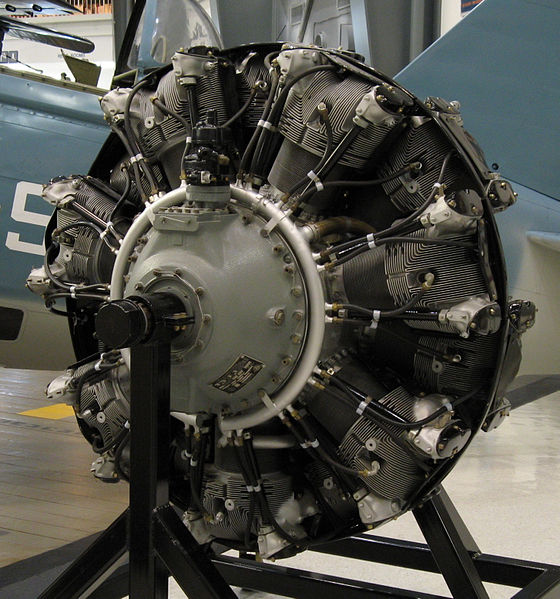
Pratt & Whitney PW-1535 at Naval Aviation Museum, Pensacola, Florida - photograph by Greg Goebel
From about 1940 -1943 things progressed along with successful testing of the engine, a wind-tunnel model, a mockup and component parts manufacture. Indeed, NACA-Langley was already in discussions with the Curtiss-Wright aircraft company to take over continued construction of the airframe. From historical research and photographs, at least the fuselage was constructed. Things may have gotten a little further, but many of the old records were accidentally destroyed, deteriorated or were lost.
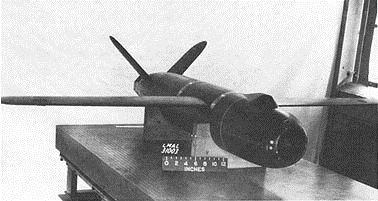
NACA - Langley - Jacobs - Jeep wind-tunnel test model - NASA-NACA image
Things came to an abrupt end for the Jeep project in 1943 during the construction phase when the USAAF announced the cancellation of the project with their choice of the Bell P-59 (which had already flown in October, 1942) and later the Lockheed P-80 (1/72 Airfix, Sword, TANMODEL, Monogram, HASEGAWA). Meanwhile the USN had selected the McDonnell XFD-1 Phantom. All were powered by conventional centrifuge and axial-flow turbojets. In between these developments the US Navy had also experimented with designs similar to those used by the Soviet Union for their Mikoyan-Gureyvich MiG-13 (1/72 Omega) and Sukhoi Su-5 (1/72 fPROP & JET, MPM, Master-X) in which a piston engine powering the propellor worked in conjunction with a motor or independent of a jet engine. These aircraft were the Ryan FR-1 Fireball (1/72 Pegasus, MPM, Airmodel), Ryan XFR-2 Dark Shark (1/72 MPM) and Curtiss XF15-C1 (1/72 Pro Resin).
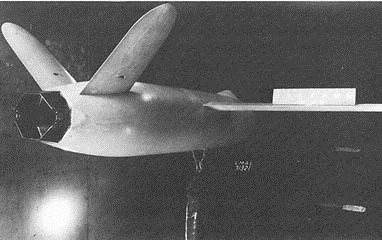
NACA - Langley - Jacobs - Jeep model in wind-tunnel - NASA-NACA image
It should be noted here that compared to other US jet aircraft of the time, the Jeep would have proven beneficial for speed. In fact, some on the Military Advisory Committee felt that this totally American development would have brought about better results while others thought that importation of the jet engines from Great Britain was more beneficial. Thus, a part of the reason that research continued was because of support by some for a completely American jet powered aircraft. The Jacobs-Wasilewski engine was, in fact, a turbofan. The chart below compares the Jeep to other jet-powered aircraft of 1943 or near completion at that time. Building of the Jeep continued on in 1943, it's final fate remains unknown (at least as far as IRMA can find out).
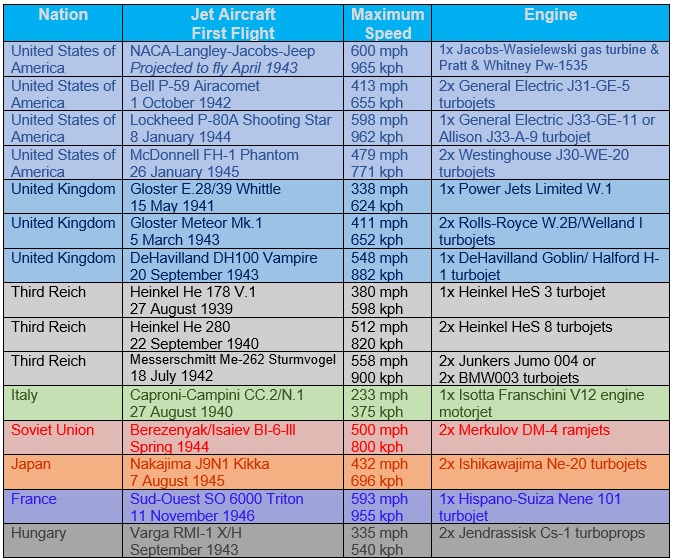
Chart compiled by Zane R Nobbs
After cancellation, Dr. Jacobs continued work on the Jeep until the NACA funding ran out. He then focused his research to include atomic power for jet aircraft, however, upon learning of the parallel jet aviation programs utlized by the USAAF and USN, he felt betrayed that they had him working on research that they knew would never be used. He resigned in protest in 1944 in the form of an early retirement at only 42 years of age.

Dr. Eastman Jacobs - NASA-NACA photograph
In retirement Dr. Jacobs worked on the family ranch, tinkered with aircraft, boats, steam engines and worked on improving telescopes. A bit later he opened a restaurant near Los Angeles named Neptune's Net. He died on 21 June 1987.
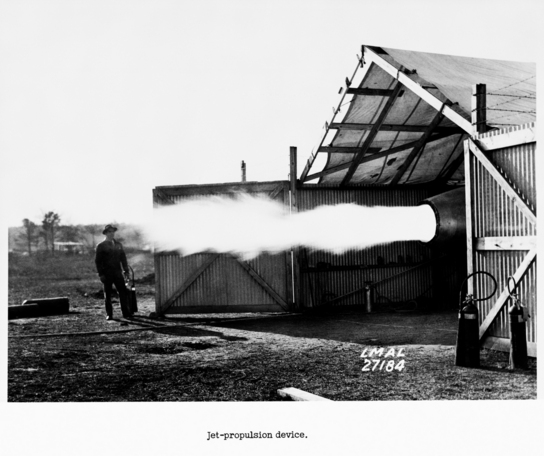
NACA-Langely-Jacobs-Jeep engine test with completed fuselage - Photograph courtesty of NASA-NACA
Based on current research it appears that the Jeep made it at least to engine and fuselage construction. It may have even been completed or nearly so, however, during the 1940s most projects cancelled by the government, especially related to new aviation technology, required destruction of all prototypes and component parts. Indeed it was only by accident that the early Northrop N-9MB Flying Wing survived because no one knew where it was for so long. This could be the case with the Jeep too. It may have been completed and stored away in a government warehouse waiting for someone to locate it for display. Who knows?
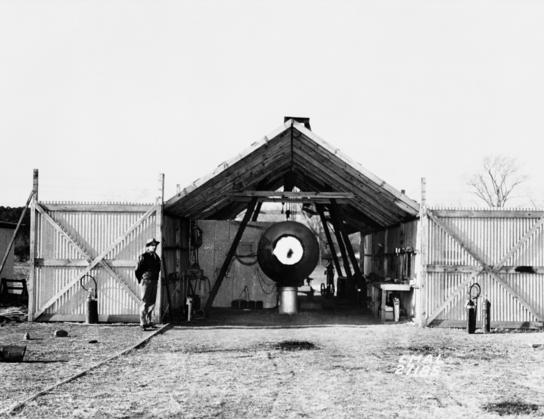
NACA-Langley-Jacobs-Jeep engine testing of completed fuselage - Photograph courtesy of NASA-NACA
Regardless, the Jeep was an accomplishment in research alone and would have been a quick, pratical solution for the USA to get into the jet aircraft field earlier if necessary. At least it was a soluible backup plan. For this reason and others, the International Resin Modellers Association has chosen this subject for IRMA Kit No. 10 NACA-Langley-Jacobs-Jeep in honor of Dr. Jacobs and the National Advisory Committee for Aeronautics - NACA.
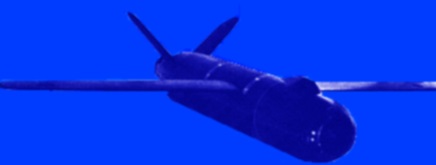
NACA - Langley - Jacobs - Jeep "In Flight" modified from NASA-NACA image by Zane R Nobbs

Model and photograph by Zane R Nobbs
IRMA would also like to thank the good people at the National Aeronautical and Space Administration - NASA Center for AeroSpace Information on the National Advisory Committee for Aeronautics - NACA and the NASA Langley Research Center for their help in obtaining photos, data and reference information.
Dimensions:
Wingspan: 36' 11" (11.25 m)
Length: 27' 5" (8.35 m)
Height: 8' 11" (2.73 m)
Weight: Unknown
Performance:
Maximum Speed: 600 mph (966 kph) - planned from Jacobs Test Rig
Range: Unknown
Thrust: Unknown
Crew: 1x pilot
Armament: None
Engine: 1x Pratt & Whitney PR-1535 Twin Wasp, Jr. radial piston & 1x N.A.C.A. motorjet with eight-stage axial-flow compressor
- Zane R Nobbs, 2013, © Copyright IRMA
References for this article:
Engineer in Charge: A History of the Langley Aeronautical Laboratory, 1917-1958, by James R Hansen, National Aeronautics and Spade Administration, 1986
Airfoild Section Characteristics as Affected by Variations of the Reynolds Number, by Eastman N Jacobs and Albert Sherman, National Advisory Committee for Aeronautics, Report No. 586, 1937
Performance of NACA Eight-Stage Axial-Flow Compressor Designed on the Basis of Airfoil Theory, by John T Sinnette, Jr, Oscar W Schey and J Austin King, National Advisory Committee for Aeronautics, Report No. 758, 1943 (an evaluation of the compressor by Eastman N Jacobs and Eugene Wasielewski)
NACA-National Advisory Committee for Aeronautics: The Organization - Research Activities and Facilities of the NACA, by the National Committee for Aeronautics, 1948
Development of Aircraft Engines & Development of Aviation Fuels: Two Studies of Relations Between Government and Business, by Robert Schlaifer and S D Heron, Division of Research, Graduate School of Business Administration, Harvard University, 1950
American Secret Projects: Fighters and Interceptors 1945-1978, by Tony Butler, Midland Publishing, 2007
Turbojet History and Development 1930-1960, Volume 2: USSR, USA, Japan, France, Canada, Sweden, Switzerland, Italy and Hungary, by Antony L Kay, Crowood Press, 2007
The Development of Jet and Turbine Aero Engines, by Bill Gunston, Patrick Stephens Limited, 1995
Rand McNalley Encyclopedia of Military Aircraft, by Enzo Angelucci, Military Press, 1980
The International Encyclopedia of Aviation, by David Mondey, Crown Publishing, 1977
Graphic images on this page copyright by IRMA 2013
Images on this page are used by permission or believed to be in the public domain. If you own one or more images and can prove you are the original owner, we will remove the image(s).
Artwork on this page by Zane R Nobbs
Box Art by Zane R Nobbs
Copyright International Resin Modellers Association©SM®TM. I.R.M.A. (IRMA) ©SM®TM. All rights reserved.
All images on this site are copyright protected internationally. All unauthorized use is tracked and filed. You may use images wtih permission and proper credit given to the site, manufacturer and model builder. Please do not use images without permission.
Any advice, suggestions, methods or recommendations given on this site are taken solely at the visitors discretion, responsibility and risk. The International Resin Modellers Association©SM®TM and any companies, organizations, individuals or other entities listed on this site or associated therewith are not responsible for any actions taken by visitors to this site. Please be very careful when doing any modelling and always remember: SAFETY FIRST! Happy modelling!
Any materials sent to the International Resin Modellers Association© shall remain the property of their respective owners with the understanding that upon receipt of materials, including written, photographic, graphic and any others, permission is granted for their use in any forum and format on this site and includes use by other sites or individuals related to this one. This site is not responsible in any way for misuse or distribution of said materials in or out of its control. This site also reserves the right to edit or format contributed materials for content and context. Materials displayed on this site are copyright by the International Resin Modellers Association©.
Images on this site not created by the International Resin Modellers Association are believed to be in the public domain. If you own an image, can verify it, and wish it to be removed, please contact us.
IRMA reserves the right to change prices for products, services or memberships without prior notice as well as changing site content, format and structure without prior notification.
The phrase and name International Resin Modellers Association is registered, copyrighted and trademarked internationally along with the phrase and wording internationalresinmodellers with a .com, .org or any other extension and also includes the logo and any variations (internationalresinmodeller, internationalresinmodelers, internationalresinmodeler and etc. with any and all extensions). Any infrigement, copying or unauthorized use is subject to an indemnity of U.S. $5,000,000 payable to the International Resin Modellers Association©SM®TM or Zane R Nobbs. And all legal expenses (court costs, attorney fees and etc.) and other expenses will be paid by the perpetrator(s) separately and in addition to the aforementioned indemnity.
International Resin Modellers Association ©SM®TM
Zane R Nobbs
405 Old Orchard Drive, 18
Essexville, MI 48732
United States
ph: 001-989-891-1401
fax: 001-989-891-1401
alt: 001-989-465-6241
info
